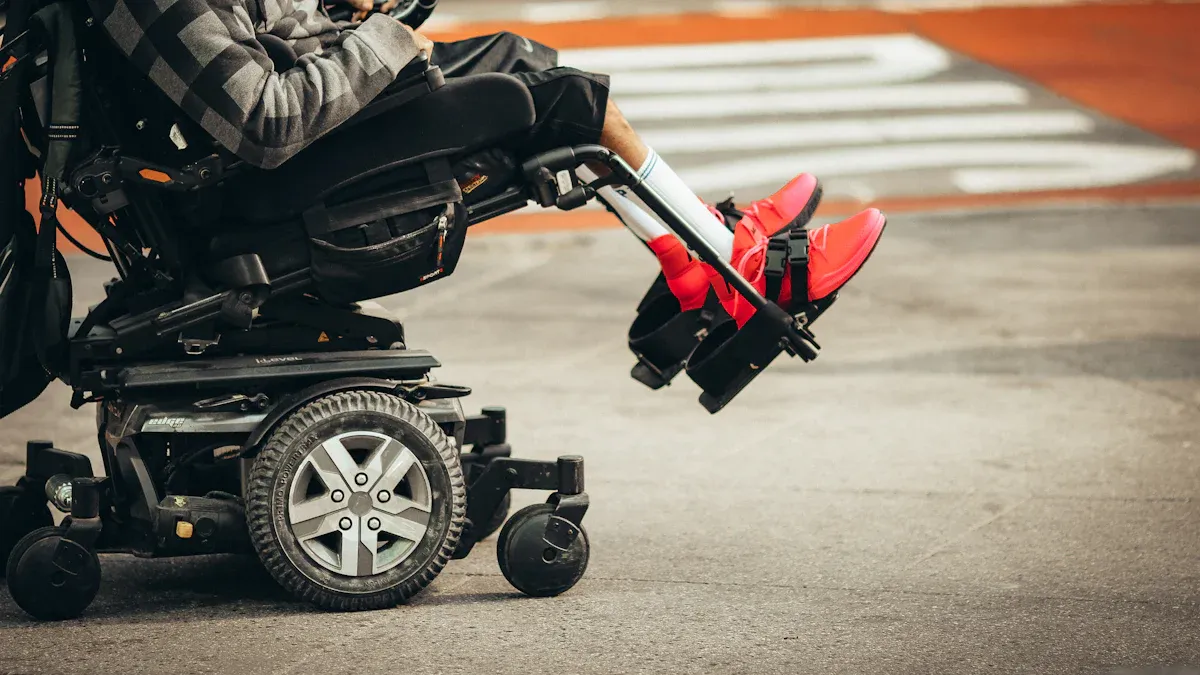
Choosing the right electric wheelchair can feel overwhelming. People see more options every year as the market grows, with new models like the foldable wheelchair and smart features. The chart below shows how demand for motorized wheelchair models keeps rising.

Shoppers want a wheelchair electric that matches their lifestyle and feels comfortable.
Key Takeaways
- Choose an electric wheelchair that fits your daily needs by thinking about where you will use it most—indoors, outdoors, or both—and how easy it is to move in your usual spaces.
- Look for comfort and safety features like adjustable seats, good support, and safety belts to stay comfortable and protected every day.
- Check the battery life and charging options to make sure your wheelchair can keep up with your travel needs, and find a brand with good warranty and local support for peace of mind.
Electric Wheelchair Usage Environment

Indoor vs. Outdoor Performance
People use electric wheelchairs in many places, so it helps to know how each model works indoors and outdoors. Indoors, users often drive forward and backward, turn, and move through tight spaces. These tasks seem simple, but they matter for daily life. Outdoors, things get harder. Users face ramps, doorways, soft ground, and even moving obstacles. Outdoor use needs more skill and a wheelchair that can handle rougher conditions. Some models, like the Moti-Go, perform better on rough surfaces than others. For indoor use, most electric wheelchairs show similar results on smooth floors.
Tip: Try to picture where you will use your wheelchair most. Will you spend more time inside or outside?
Terrain and Accessibility Needs
Not all surfaces are the same. Smooth floors inside a home feel very different from gravel paths or grassy parks. A study found that rough surfaces make it harder to push and use a wheelchair. The Moti-Go model lets users travel farther and with less effort on rough ground than the KidChair. On smooth surfaces, both models work about the same. People who need to go outside often should look for a wheelchair that handles bumps and uneven ground well.
| Surface Type | Model | Distance Traveled | Effort Needed |
|---|---|---|---|
| Rough | Moti-Go | Longer | Less |
| Rough | KidChair | Shorter | More |
| Smooth | Both | Similar | Similar |
Space and Maneuverability
Space matters, especially indoors. Some homes have narrow hallways or small rooms. A wheelchair with a tight turning radius helps users move around furniture and corners. Outdoor areas may offer more space, but users still need to get through doors and ramps. People should measure their usual spaces before choosing a wheelchair. This step helps avoid surprises and makes daily life easier.
Electric Wheelchair Drive System
Rear-Wheel, Mid-Wheel, or Front-Wheel Drive
Choosing the right drive system can change how an electric wheelchair feels and works every day. Each type has its own strengths and challenges. Here’s a quick look at how they compare:
| Drive System | Advantages | Limitations | Key Points |
|---|---|---|---|
| Front-Wheel | Handles outdoor terrain well, smooth ride, easy to get close to objects | Larger turning radius, needs more driving skill | Good for tight turns in front direction |
| Mid-Wheel | Smallest turning radius, easy to drive indoors, stable on ramps | More bumps from six wheels, can get stuck on uneven ground | Combines indoor and outdoor benefits |
| Rear-Wheel | Stable outdoors, tracks well at higher speeds | Large turning radius, not as good indoors | Easier over soft ground, less indoor maneuvering |
Front-wheel drive lets users get closer to tables or counters. Mid-wheel drive feels natural because the user sits over the drive wheels. Rear-wheel drive works best for outdoor trips and higher speeds. Everyone should think about where they will use their wheelchair most.
Tip: Try out different drive systems before making a choice. Each one feels different in real life.
Turning Radius and Handling
Turning radius means how tightly a wheelchair can turn. A smaller turning radius helps users move in tight spaces like bathrooms or elevators. Here are some things to keep in mind:
- Turning radius measures the distance from the center of the drive wheels to the farthest point on the base.
- Smaller turning radius means better movement in small rooms or crowded places.
- Users should check the size of their wheelchair and the spaces they use most.
- Maneuverability is not just about fitting into a space. It also means having enough room to turn and leave.
- Trying out a wheelchair in real-life settings or using a demo can help people see how it handles.
- Manufacturer guides and specs can help compare different models.
A good turning radius makes daily life easier, especially indoors. People should always test how a wheelchair moves before buying.
Electric Wheelchair Comfort and Fit
Seat Size and Cushioning
A good seat makes a big difference in daily comfort. People come in all shapes and sizes, so the seat on an electric wheelchair should fit the user’s body. A seat that is too small can cause pressure points and pain. A seat that is too large may not give enough support. Many users look for seats with extra cushioning. Soft cushions help prevent soreness and make long rides easier. Some seats use memory foam or gel to spread out weight and reduce pressure.
Tip: Try sitting in different seats before choosing. Notice how your back and legs feel after a few minutes.
Backrest and Armrest Adjustments
Adjustable backrests and armrests help users stay comfortable and avoid strain. Research using special sensors shows that these features play a big role in comfort. When users adjust the armrests, their elbows rest naturally and their shoulders relax. This reduces strain on the upper body. Adjustable backrests support the spine and help keep a healthy posture. They also help spread out body weight, which lowers the risk of pressure sores.
- Adjustable armrests let elbows rest in a natural spot.
- Adjustable backrests support the lower back and improve posture.
- Good adjustments help prevent pain and pressure spots.
Customization and Adjustability
No two people have the same needs. Customization lets users change their electric wheelchair to fit their bodies and lifestyles. New technology, like 3D scanning, helps make wheelchairs that fit better than ever. Experts say that a well-fitted wheelchair improves comfort, mobility, and quality of life. Adjustable features, such as seat height or footrests, help users stay comfortable all day. Custom options also make it easier for people with different disabilities to find the right fit.
Note: A wheelchair that fits well can make daily life easier and more enjoyable.
Electric Wheelchair Battery Life and Range
Daily Travel Distance
Battery life matters a lot for anyone who uses an electric wheelchair every day. Most people want to know how far they can go on a single charge. On average, a full battery lets users travel between 10 and 20 miles. This range works well for most daily routines. Some users report that they can go up to 5 miles on mixed terrain before the battery indicator turns orange, which means about 30% charge left. The farthest single trip on one charge can reach around 7 miles and usually lasts about an hour.
Several things can change these numbers:
- User weight
- Type of ground (smooth floors, grass, gravel)
- Hills or ramps
- Speed (most chairs go up to 15 miles per hour)
Battery indicators help users plan their trips. Green means plenty of charge, orange means time to think about heading home, and red means the battery is almost empty.
Tip: Always check the battery level before leaving home, especially for longer trips.
Charging Time and Accessibility
Charging an electric wheelchair should fit easily into daily life. Most batteries need several hours to reach a full charge. Many people plug in their wheelchair overnight so it is ready in the morning. Some models have removable batteries, which makes charging more flexible. Users can take the battery inside and charge it anywhere with an outlet.
Easy access to charging spots helps avoid stress. People should look for models with clear battery indicators and simple charging ports. This way, they can keep their wheelchair ready for any adventure.
Electric Wheelchair Controls and Features
Joystick and Control Panel Options
Every electric wheelchair comes with a way to steer and control speed. Most people use a joystick because it feels easy and natural. Some joysticks sit on the armrest, while others can move to fit the user’s needs. Control panels often show battery life, speed, and error messages. Some models offer touchscreens or buttons for extra features. People with limited hand movement can choose special controls, like chin or head arrays. These options help everyone find a setup that works for them.
Tip: Try different joystick styles before picking one. A comfortable control makes driving much easier.
Advanced Features (Tilt, Recline, Elevate)
Modern electric wheelchairs offer more than just basic movement. Advanced features like tilt, recline, and elevate help users stay comfortable and healthy. For example, power recline lets the seat lean back up to 165 degrees. This helps prevent pressure injuries and makes breathing easier. Power tilt can shift the seat up to 25 degrees, which helps with posture and skin health. Elevate features raise the seat up to 12 inches, so users can reach shelves or talk to people at eye level.
Here’s a quick look at what these features do:
| Feature | What It Does | How It Helps Users |
|---|---|---|
| Power Recline | Leans seat back up to 165° | Prevents sores, helps breathing, aids digestion |
| Power Tilt | Tilts seat up to 25° | Improves posture, comfort, and skin health |
| Power Elevate | Raises seat up to 12″ | Helps reach things, supports social interaction |
| Power Leg/Foot Supports | Lifts and positions legs and feet | Reduces swelling, helps with transfers |
| Power Standing | Raises user to standing angle up to 85° | Boosts bone health, improves circulation |
| Memory Seating | Saves favorite seat positions | Makes daily use easier and safer |
These features can make a big difference in daily life. They help users stay active, comfortable, and connected with others.
Electric Wheelchair Transport and Portability

Weight and Foldability
When people look for a wheelchair they can take anywhere, weight and foldability matter a lot. Many foldable wheelchairs use lightweight materials like carbon fiber. This makes them easier to lift and store. Some users still find these chairs heavy, especially if they need to move them alone. Foldable models often have a wider wheelbase and more mass. This can make them harder to turn and slower to drive. A study showed that these features can lower speed and make the chair less energy efficient. Even so, foldable wheelchairs help people who travel often or have little storage space. They fit in closets, car trunks, or under beds.
Tip: Always check the total weight before buying. Try lifting or folding the chair if possible.
Disassembly for Travel
Some wheelchairs come apart into smaller pieces. This helps when someone needs to pack the chair in a car or take it on a plane. Most designs let users remove the seat, battery, or wheels. Smaller parts are easier to lift and fit in tight spaces. People should look for chairs with simple release buttons or handles. This makes taking the chair apart quick and easy. Disassembly can help families or caregivers who help with travel.
- Look for chairs with tool-free disassembly.
- Practice taking the chair apart before a big trip.
- Keep track of all parts to avoid losing anything.
Vehicle Compatibility
Not every wheelchair fits in every car or van. Some models fold up small enough for a trunk. Others need a ramp or lift to get inside. People should measure their car’s trunk or back seat before buying a wheelchair. Some vans have special tie-downs or docking systems for wheelchairs. It helps to ask the dealer if the chair works with these systems. Planning ahead saves time and stress on travel days.
| Vehicle Type | Fits Folded Chair | Needs Ramp/Lift | Special Tie-Downs |
|---|---|---|---|
| Sedan | Often | Rarely | No |
| SUV | Usually | Sometimes | No |
| Van | Yes | Often | Yes |
Note: Always test loading the wheelchair into your vehicle before making a final choice.
Electric Wheelchair Weight Capacity and Safety
Maximum User Weight
Every wheelchair has a weight limit. This number tells users how much weight the chair can safely support. Most adult models hold between 250 and 400 pounds. Some heavy-duty chairs support even more. Choosing a chair with the right weight capacity helps prevent damage and keeps the user safe. If someone picks a chair with too low a limit, the frame or motor might break. The seat and wheels can also wear out faster. People should always check the label or manual for the maximum user weight before buying.
Tip: Always leave a little room between your weight and the chair’s limit. This helps the chair last longer and work better.
Stability and Safety Features
Safety matters every day. Wheelchairs can tip over if users drive over curbs or steep ramps. Research shows that sideways tips and forward falls happen mostly because of curb height and the angle of approach, not speed. These falls can cause serious injuries, like concussions. Using a seatbelt lowers the risk of life-threatening trauma, but not everyone uses them. Injury prevention is important for everyone.
Some safety features to look for include:
- Anti-tip wheels to stop the chair from flipping backward
- Stable wheelbase for better balance
- Seatbelts or harnesses for extra security
- Bright lights and reflectors for better visibility
Many wheelchairs meet special safety standards for travel. The WC19 standard checks if a chair stays strong in a crash and if seatbelts fit right. Only about 40% of users use crashworthy belt restraints correctly, so design matters a lot.
| Standard Name | Key Tests | Purpose |
|---|---|---|
| WC19 | Crash tests, belt fit, frame strength | Keeps users safe during vehicle travel |
Note: Good design and the right features help keep users safe at home and on the road.
Electric Wheelchair After-Sales Support
Warranty and Service Plans
A good warranty gives peace of mind. Most brands offer a warranty that covers the frame, motor, and battery. Some plans last one year, while others go up to five years. Service plans can help with regular checkups or repairs. People should ask what the warranty covers and how long it lasts. They should also check if the plan includes labor costs or just parts. A strong warranty shows that the company stands behind its product.
Tip: Always keep a copy of the warranty and service plan in a safe place. It helps if something goes wrong.
Local Support and Repairs
Quick repairs matter when someone relies on a wheelchair every day. Local support makes life easier. Many dealers have repair shops or send technicians to the home. Some brands offer phone support or online help. People should ask if there is a service center nearby. They should also find out how fast repairs happen. Fast support means less time without a working chair.
- Ask about local repair shops.
- Check if the company offers home visits.
- Find out how long repairs usually take.
Replacement Parts Availability
Parts wear out over time. Easy access to replacement parts keeps a wheelchair running smoothly. Some brands keep parts in stock, while others may take weeks to ship. People should ask how to order parts and how long delivery takes. They should also check if common parts, like batteries or tires, are easy to find. Good parts support means less waiting and more independence.
Note: A chair with easy-to-find parts saves time and stress in the future.
Electric Wheelchair Price and Budget
Upfront Cost vs. Long-Term Value
Price tags can surprise many shoppers. Some wheelchairs cost less at first but need more repairs or upgrades later. Others have a higher price but last longer and need fewer fixes. People often look at the sticker price and forget about long-term value. A sturdy chair with good support may save money over time. It can also bring more comfort and fewer worries.
Here are a few things to check before buying:
- How long does the chair usually last?
- Are replacement parts easy to find?
- Does the warranty cover common problems?
- Will the chair need special batteries or tires?
Tip: Spending a bit more now can mean fewer headaches later.
Insurance and Financing Options
Paying for a wheelchair can feel tricky. Some people use insurance, while others pay out-of-pocket. Insurance can help, but it does not always cover every model or feature. Many buyers face delays or denials. In fact, about 43% of people reported insurance denials for their device in the past five years. Medicare Advantage users had the lowest denial rate at 32%, while those with both Medicare and Medicaid saw the highest at 46%. Private insurance users faced a 37.5% denial rate. About 25% of buyers paid without insurance, which gave them more freedom but higher costs.

Here is a quick look at how people pay for their wheelchairs:
| Payment Method | Percentage of Buyers |
|---|---|
| Medicare/Medicaid | 35% |
| Private Insurance | 24% |
| Out-of-Pocket/Other | 25% |
Planning ahead helps. People should gather paperwork, ask about coverage, and check for payment plans or grants. Some dealers offer financing to spread out payments.
Asking the right questions helps shoppers find a wheelchair that fits their life. Comfort, safety, and support matter as much as features or price.
- Companies now offer ergonomic seating, adaptive controls, and posture monitoring.
- Safety features include obstacle detection and stability control.
- Smart navigation and remote monitoring boost independence.
FAQ
How long does an electric wheelchair battery usually last?
Most batteries last between 1 and 3 years. Daily use, charging habits, and terrain can affect battery life.
Can someone use an electric wheelchair in the rain?
Light rain is usually safe for short trips. Heavy rain or puddles can damage the electronics. Always dry the chair after getting wet.
What should a person do if their wheelchair stops working suddenly?
Stay calm. Check the battery and power switch first. If the chair still will not move, contact the dealer or service center for help.
Post time: Jun-26-2025
